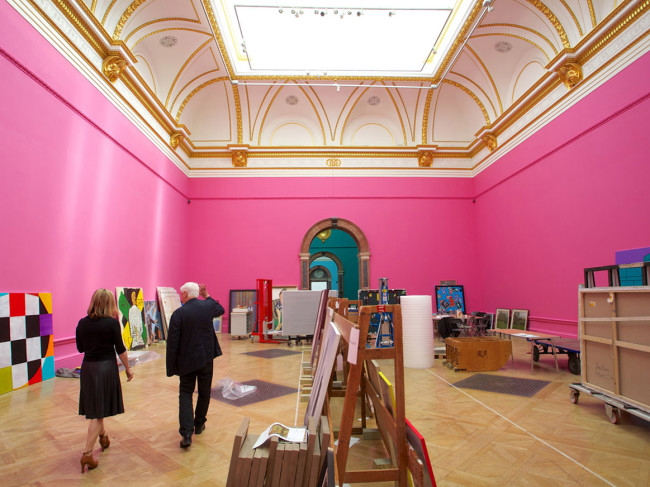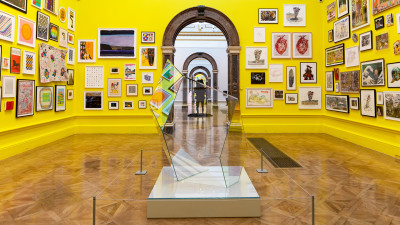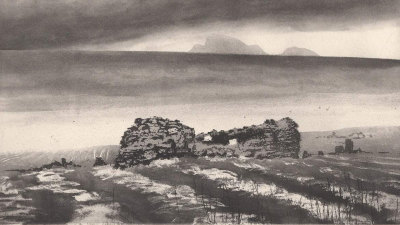Bombs, dots and rockstars: seven stories of the Summer Exhibition
Bombs, dots and rockstars: seven stories of the Summer Exhibition
By Helen Butcher
Published 9 June 2022
From frenemy feuds to a bomb through the roof, the storylines of the Summer Exhibition could make a TV drama – so no wonder it’s often featured on screen. Here are just a few of our favourite episodes…
-
An earlier version of this article was published in June 2018.
-
-
1. The one with a teenage Turner
When Turner joined the Royal Academy Schools at the age of 14, he had already entered the public realm thanks to his father, who exhibited and sold his son’s works in his barber shop in Covent Garden. For his first submission to the Summer Exhibition in 1790, Turner selected a turbulent seascape, Fishermen at Sea, which set itself apart from others with its dramatic light and handling of paint. He then regularly submitted paintings at the RA throughout his life, battling with Constable for landscape supremacy. Ever the self-publicist, Turner often used Varnishing Day – traditionally when artists came into the galleries once the exhibition was hung to add the final touches to their work – as a chance to transform his canvases in front of an eager audience.

-
-
-

2. The one with the dots
Seen those red dots under artworks, indicating that they’ve been sold? Well, they first appeared in the Summer Exhibition in 1865 – and soon caught on in the art world. Cornelia Parker RA even incorporated them into her own work, Stolen Thunder (Red Spot), where she took a photo of one of the most successful prints in the 2012 show, and digitally erased the image, keeping the red spots as part of the piece.
-
-
-
3. The one with the meat cleaver
On 4 May 1914, the suffragette Mary Wood smuggled (you guessed it) a meat cleaver into the Summer Exhibition. She used it to slash John Singer Sargent’s portrait of the writer Henry James, breaking through the glass and slashing the canvas three times. Wood stated that she tried to destroy it to “show the public that they have no security for their property nor for their art treasures until women are given political freedom.” However, Wood may also have chosen this portrait, painted by an elder statesman of the artistic elite, to challenge the bastion of conservatism.

-
-
-

4. The one that got bombed
The Summer Exhibition has continued uninterrupted every year since 1769, even throughout both World Wars. In 1917, a bomb from a German Gotha plane dropped through the roof of Gallery IX (you can still make out the shrapnel scars in the galleries; in the Summer Exhibition, look out for them on the doorframe between Gallery IX and the Lecture Room). The Academy struggled financially as a result of the war, so in 1918, it printed its first ever Summer Exhibition poster in the hope of boosting visitor figures. We’ve had fun making them ever since – you can see them and buy one downstairs in the shop or in the Poster Bar.
-
-
-
5. The one where we went “new age”
1955: Britain had a new Queen, the ailing Winston Churchill (who regularly entered the Summer Exhibition under a pseudonym) had resigned as Prime Minister, and The Dam Busters had just been released in cinemas. That year, the BBC also decided to broadcast a TV programme for the first time inside our galleries. The exhibition received an unusually high number of visitors, with many drawn by Pietro Annigoni’s portrait of Queen Elizabeth II after her coronation (which went on display in our 2018 exhibition, The Great Spectacle).

-
-
-

6. The one with the rock stars
As Pop took hold of London in the ‘60s and ‘70s, so too did it take hold of the Summer Exhibition. Having famously designed the Sgt. Pepper’s Lonely Hearts Club Band record sleeve in 1967, artist Peter Blake designed the poster for the 1975 Summer Exhibition. But it was 26 years later when – the likes of Tracey Emin and Damien Hirst having forced a reassessment of what could be considered “art” in the RA’s Sensation exhibition in 1997 – Blake co-ordinated the Summer Exhibition. He included works by musicians Paul McCartney and Ronnie Wood, as well as Hirst and Emin.
-
-
-
7. The one where Summer was in winter (again)…
A bomb through the roof couldn’t stop the Summer Exhibition, and neither could a global pandemic. For the past two years, for the first time in the exhibition’s history, it was postponed from the summer months and took place October – January instead.
But this year, we’re very excited to be back to our usual spot in summertime for coordinator Alison Wilding RA’s Climate-themed show.

-
-
-

Visit the Summer Exhibition
21 June — 21 August 2022
Summer at the RA is not just a time of year, it’s the world’s most joyful art experience.
Run without interruption since 1769, the Summer Exhibition showcases art in all forms, from prints, painting, film and photography, to architectural works and sculpture by invited artists, Royal Academicians and emerging talent.
-











